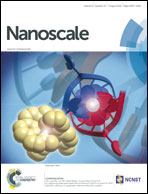Morphology-tunable synthesis of ZnO nanoforest and its photoelectrochemical performance†
Abstract
Understanding and manipulating synthesis reactions and crystal growth mechanisms are keys to designing and constructing the morphology and functional properties of advanced materials. Herein, the morphology-controlled synthesis of three-dimensional (3D) ZnO nanoforests is reported via a facile hydrothermal route. Specifically, the respective and synergistic influence of polyethylenimine (PEI) and ammonia on tuning the architecture of ZnO nanoforests is systematically studied. An in-depth understanding of the mechanism of hydrothermal growth is vital for advancing this facile approach and incorporating special 3D nanostructures into versatile nanomanufacturing. More importantly, its unique architectural characteristics endow the willow-like ZnO nanoforest with prominent photoelectrochemical water splitting performance, including small charge transfer resistance, long photoelectron lifetime, a high photocurrent density of 0.919 mA cm−2 at +1.2 V (vs. Ag/AgCl), and more important, a high photoconversion efficiency of 0.299% at 0.89 V (vs. RHE), which leads the realm of homogeneous ZnO nanostructures. In all, it is expected that this work will open up an unprecedented avenue to govern desirable 3D ZnO nanostructures and broaden the application potentials of 3D nanotechnology.


 Please wait while we load your content...
Please wait while we load your content...